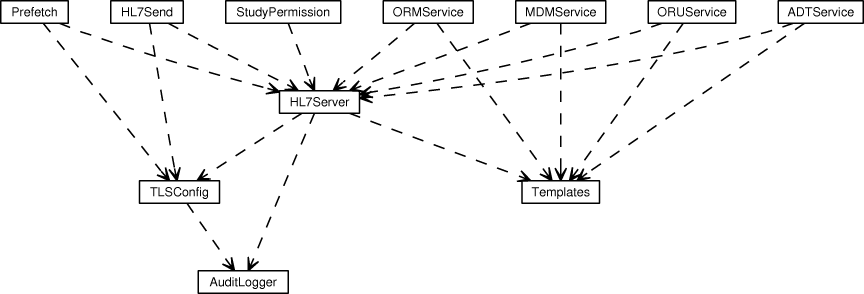...
HL7 Server: Dispatch incoming HL7 messages to registered HL7 services. When configuring, select the TCP listening port, the security protocol for communication, timeouts, and the maximum number of connected HL7 senders.
Dependencies
Attributes
#CharsetName
| Anchor | ||||
|---|---|---|---|---|
|
Specifies Charset of incoming and outgoing HL7 messages by its name as listed in the IANA Charset Registry (e.g. ISO-8859-1).
Default Value: ISO-8859-1
#Port
| Anchor | ||||
|---|---|---|---|---|
|
TCP listening port. This is the most important value in the service.
Default Value: 2575
#LocalAddress
| Anchor | ||||
|---|---|---|---|---|
|
Local interface IP address to listen for TCP communication. 0.0.0.0 indicates all active interfaces.
Default Value: 0.0.0.0
#ProtocolName
| Anchor | ||||
|---|---|---|---|---|
|
...
Default Value: ADT^A02,ADT^A03,ADT^A06,ADT^A07,ADT^A12,ADT^A13
#SuppressErrorResponse
| Anchor | ||||
|---|---|---|---|---|
|
Activates suppression of Application Reject or Application Error as acknowledgment code but always returns acknowledgment code AA (=Application Accept), even if the processing of the message fails.
Default Value: false
#SendNotification
| Anchor | ||||
|---|---|---|---|---|
|
Activates notification of registered listeners about received HL7 messages. Required for message forwarding by #HL7 Send Service and for prefetch of studies on receive of ORM^O01 messages by the #Prefetch Service.
Default Value: true
...
Activates suppression of Application Reject or Application Error as acknowledgment code but always returns acknowledgment code AA (=Application Accept), even if the processing of the message fails.
Default Value: false
#FileReceivedHL7
| Anchor | ||||
|---|---|---|---|---|
|
...
Activates writing received and XMLized HL7 messages into file (format: hl7-######.xml, with ###### as the sequence number of the received message since last application start) in log directory. Useful to test customized XSL stylesheets used by individual HL7 Services.
Default Value: false
#TcpNoDelay
| Anchor | ||||
|---|---|---|---|---|
|
Send packets as quickly as possible (Disable Nagle's algorithmn). This should increase performance on a Windows operating system.
Default Value: true
#SendBufferSize
| Anchor | ||||
|---|---|---|---|---|
|
Buffer size used for socket output. 0 = use platform default.
Default Value: 0
#ReceiveBufferSize
| Anchor | ||||
|---|---|---|---|---|
|
Buffer size used for socket input. 0 = use platform default.
Default Value: 0
#MaxClients
| Anchor | ||||
|---|---|---|---|---|
|
...
Default Value: conf/dcm4chee-hl7/logmsg.xsl
#PreprocessTemplateDir
| Anchor | ||||
|---|---|---|---|---|
|
Directory where template file(s) are located to preprocess the received HL7 message.
A stylesheet can be message type specific ("preprocess_<MSG Type>^<Event Type>.xsl" or "preprocess_<MSG Type>.xsl") or generic "preprocess.xsl" and placed in this directory or in a sub-directory to select a style sheet according to the sender.
This sub-directory can be <IPAddr>, <hostname> or '<Sending Application>^<Sending Facility>' (In this order).
(See also UseHostSubdirs attribute in HL7Server service to enable IP/hostname selection)
A relative path name is resolved relative to archive-install-directory/server/default/.
Default Value: conf/dcm4chee-hl7
#UseHostSubdirs
| Anchor | ||||
|---|---|---|---|---|
|
Enable selection of style sheets depending on IP address/hostname.
If disabled, only Sending Application and Sending Facility can be used to select style sheet depending on message sender but eliminates need of DNS lookup to get hostname.
Default Value: false
#TLSConfigName
| Anchor | ||||
|---|---|---|---|---|
|
...
